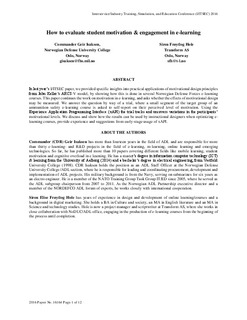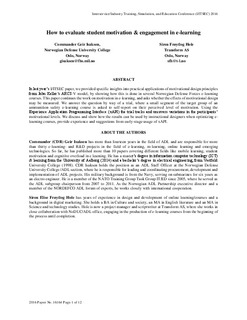| dc.contributor.author | Isaksen, Geir | |
| dc.contributor.author | Hole, Siren Frøytlog | |
| dc.date.accessioned | 2016-10-04T11:45:57Z | |
| dc.date.accessioned | 2017-02-16T13:48:45Z | |
| dc.date.available | 2016-10-04T11:45:57Z | |
| dc.date.available | 2017-02-16T13:48:45Z | |
| dc.date.issued | 2016 | |
| dc.identifier.uri | http://hdl.handle.net/11250/2431097 | |
| dc.description.abstract | In last year’s I/ITSEC paper, we provided specific insights into practical applications of motivational design principles from John Keller’s ARCS-V model, by showing how this is done in several Norwegian Defense Forces e-learning courses. This paper continues the work on motivation in e-learning, and asks whether the effects of motivational design may be measured. We answer the question by way of a trial, where a small segment of the target group of an ammunition safety e-learning course is asked to self-report on their perceived level of motivation. Using the Experience Application Programming Interface (xAPI) the trial tracks and uncovers variations in the participants’ motivational levels. We discuss and show how the results can be used by instructional designers when optimizing elearning courses, provide experience and suggestions from early-stage usage of xAPI. | nb_NO |
| dc.language.iso | eng | nb_NO |
| dc.rights | Attribution-NonCommercial-NoDerivatives 4.0 Internasjonal | * |
| dc.rights.uri | http://creativecommons.org/licenses/by-nc-nd/4.0/deed.no | * |
| dc.title | How to evaluate student motivation & engagement in e-learning. | nb_NO |
| dc.type | Others | nb_NO |
| dc.date.updated | 2016-10-04T11:45:56Z | |
| dc.identifier.cristin | 1389220 | |


